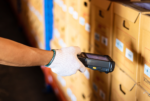In an ideal world, all of our inventory and shipping functions would run like clockwork, each product picked, placed in the right order, then packaged and shipped to the right customer. However, we live in the real world, where human error can create mishaps that result in orders being shipped to the wrong address, or sent with the wrong products. Many of these issues occur during picking and packing shipments. So, let’s discuss how effective inventory management can reduce picking and packing errors.
Understanding the Basics of Picking and Packing
To effectively manage your inventory, you must first understand the basics of picking and packing. What does pick and pack mean? What are pick and pack best practices?
What is Pick and Pack?
Pick and pack is a term used in the inventory management process. It is a three-part process within supply chain management, pretty much what it sounds like.
- Receive an order — With an integrated inventory management system, your warehouse is linked to your customer-facing ecommerce store. So, when your customer places their order, the warehouse system is notified. Then, a pick list is generated.
- Pick the order — A warehouse worker takes the generated pick list and locates the inventory items listed.
- Pack the order — The packing slips and picked items are sent to a packing station. The order is packed along with the packing slip, any documentation or equipment required. Next, it goes to shipping and delivery.
How Does Pick and Pack Work?
Depending on how your inventory warehouse is stocked, pick and pack fulfillment can be accomplished in several ways. Here are two of them.
Piece Picking
Piece picking is a commonly used picking strategy for small businesses. In this process, you take the generated packing slip for one order, then pick all of the inventory items needed for that order. Orders are picked one at a time.
Batch Picking
With batch picking, items from several orders are picked together due to something in common. Maybe they’re near each other in the warehouse or they need to be packed in a certain way.
Batch picking is used when you have a lot of small orders waiting to be fulfilled at the same time. To implement batch picking, you need batch picking software.
Grouping inventory items to be picked together saves time for your workers. Instead of going repeatedly to one inventory location, they can pick the number of items needed for all the orders at once. Then the packing team can distribute all of the items to their specific order according to the packing slips.
Recommended Workflow
Here is the recommended workflow for efficient picking and packing.
- Create pick list — A pick list is the first step in fulfilling an order. This can be done by someone in the warehouse or someone in sales or account management.
- Print pick list and packing slips — Any special circumstances for the order can be found in the notes on the packing slip.
- Pick — If you have a lot of similar orders, you can batch pick them to save time. Or you can use discrete order picking for individual orders if orders are varied. A lot of picking decisions are based on your warehouse size and the number of staff working in it.
- Pack — A packer takes the picked inventory, then divides it up by order, and packs according to the packing list (order specific). At this point, the packer needs to check picked items on the packing list for quality control. All items must match the packing list.
- Ship — The next step is to ship. You need a shipping label and appropriate postage for the carrier that will transport the package. Shipping also triggers inventory updates to your warehouse, accounting, and ecommerce store.
What are the Challenges of the Pick and Pack Process?
Human error is the culprit behind most picking and packing mistakes. These errors are costly, and can leach away your profit.
The Real Cost of Picking Errors
Picking and packing errors cost you more than the dollar amount of the order. They also cost:
- Lost sales — Due to low customer satisfaction
- Returns — Need to document and return items to inventory, return shipping cost
- Additional shipping — Cost of return shipping plus expediting correct order
- Customer service costs — Cost of customer service time resolving the error
- Repackaging — Repackaging returned item if usable
- Warehouse labor costs — Wasted labor hours on that item, required inventory count to correct the error
- Sales costs — Sales team needs to placate customers instead of making new sales
Challenges to the Pick and Pack Process
Inventory costs are a large percentage of your company’s costs per order. Therefore, it follows that additional costs due to errors reduce the bottom line. Common challenges are:
- Inaccurate inventory — Leads to incorrect scheduling and longer lead times, and/or confusion when picking.
- Factors that increase turn-around time — Turn-around time is how long it takes you to go from receiving a customer order and then shipping it out. If your turn-around time is delayed, eventually customers will look for a more reliable vendor.
- Missing product information — Causes confusion in picking, and depending what information is missing, costly errors in packing and shipping.
Seven Common Pick and Pack Errors
These pick and pack errors are the most common issues across all industries.
- Grabbing the wrong item from the right location (mishelved)
- Picking an item with a similar ID number
- Having too many people and locations
- Substituting the wrong items
- Losing order details
- Forgetting about half-picked orders
- Prioritizing the wrong things
How Ordoro Can Streamline Your Pick and Pack Workflow
Ordoro’s integrated inventory and shipping software will streamline your workflow and minimize errors.
Pick and Pack Errors Will Plummet
With Ordoro’s barcode scanning feature, you can reduce costly fulfillment errors. Select one or multiple orders, hit a button, and the app will display the items that need to be picked, scanned, and packed for shipment. Orders will be marked complete when every item is accounted for.
Raise Your Workflow’s Bar
Ordoro supports UPC barcodes, which means you can scan, set, and search UPC codes for SKUs within Ordoro. The app speeds up picking by letting you tag products with aisle and bin locations.
Sort by Location When Printing Pick and Packing Lists
It’s easy to assign an aisle, bin, and warehouse location to every product in Ordoro. Then, Ordoro will sort by location for batch picking and give you a location-ordered pick list.
Scan to Verify Pick List
Ordoro’s Scan to Verify Pick List feature uses barcode scanning to ensure product accuracy and improve your warehouse picking efficiency. Before orders are shipped, you’ll need to include any missing items.
- From the Orders tab, select orders to Scan to Verify.
- Click the Scan/Verify Contents icon, then choose PICK Items.
- Next, scan the UPC/SKU barcode for each product.
- When an item is scanned successfully, the Quantity Picked increases.
- Once the total quantity is picked, the item is removed from the list.
Bulk Scan a Selected Batch
Select a batch of orders from your order list page that you created with good barcodes.
How to Verify Multiple Orders Via Barcode Scanning
Order Verification
Ordoro’s newest version of barcode scanning allows you to verify multiple orders at one time.
Bulk scan via printed packing lists. Human error can be costly, but it happens. Using Ordoro’s Barcode Scanning, you can minimize errors by scanning each product in an order to account for every item before shipping. Here’s how:
- Scan barcode on Ordoro’s packing list to pull up order.
- Once packing list is scanned, or if you pre-selected orders, Ordoro pulls up items for those orders.
- When items are correctly scanned, you can hit the Confirm button.
- This tags the order as Contents Verified.
What Happens if the Wrong Item is Scanned in Ordoro?
IIf the wrong item is scanned or items are scanned more times than needed in the order, you get an error message.
Learn More About Inventory Management
If you’d like to learn more about Ordoro’s inventory management and shipping software, you can visit these support articles or test-drive Ordoro today. Start your 15-Day FREE Trial!


